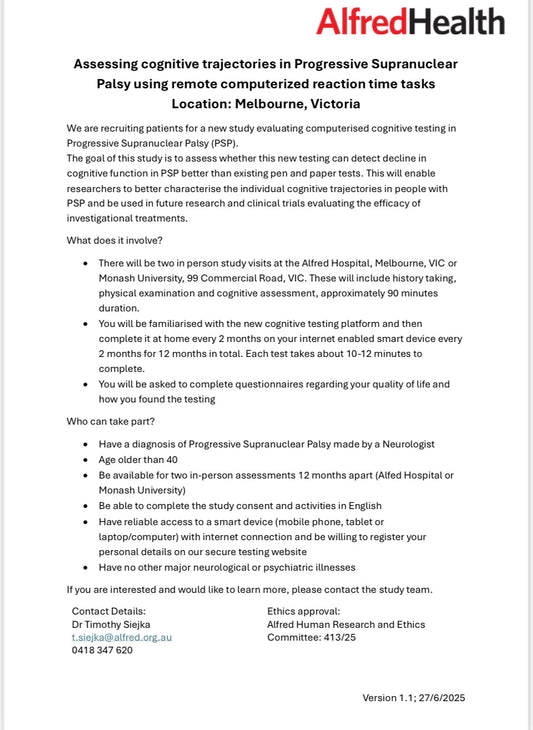Progressive Supranuclear Palsy (PSP) is a complex neurological disorder that affects each individual uniquely. While the journey may differ from person to person, medical professionals often categorize the progression of PSP into four broad stages. In this blog post, we will explore these stages to provide a comprehensive understanding of the disease’s trajectory.
Stage 1: Early PSP
In the early stages of PSP, the symptoms might be quite subtle and easily mistaken for normal aging or other neurodegenerative disorders. Some early signs may include:
- Frequent unexplained falls, typically backwards
- Difficulty with balance and mobility
- Changes in personality, such as increased apathy or mood swings
- Mild issues with eye movement, specifically in controlling upward and downward gaze
During this stage, it's common for individuals to be misdiagnosed with conditions such as Parkinson's disease or even simple aging-related issues. The accurate diagnosis of PSP at this stage can be challenging due to the overlap of symptoms with other conditions.
Stage 2: Mid PSP
As the disease progresses to the mid-stage, the symptoms become more pronounced and start to interfere with daily life. These may include:
- Increased difficulty with eye movements, often leading to blurred or double vision
- Noticeable changes in gait and balance, with frequent falls becoming a major concern
- Difficulty with speech and swallowing, leading to slurred speech and potential choking hazards
- Increased apathy and emotional changes
During this stage, the typical symptoms of PSP become more evident, often leading to a more accurate diagnosis if one hasn't been made already.
Stage 3: Advanced PSP
In the advanced stages of PSP, the symptoms can become severe and significantly affect an individual's quality of life. They may include:
- Severe difficulties with eye movements, sometimes leading to a complete inability to control eye gaze
- Increased difficulty with balance and mobility, often requiring assistive devices for movement
- Severe speech and swallowing issues, often necessitating a modified diet or feeding assistance
- Cognitive issues, such as slowed thought processes and mild memory problems
At this stage, comprehensive care and assistance become crucial for maintaining the individual's comfort and dignity.
Stage 4: Late PSP
The late stage of PSP is the most severe. Individuals at this stage may be largely immobile and require full-time assistance. The symptoms can include:
- Complete loss of eye movement
- Inability to walk or stand, requiring a wheelchair for mobility
- Severe speech and swallowing issues, potentially requiring tube feeding if chosen (always consult with healthcare professionals)
- Significant cognitive impairment
In this final stage, palliative care strategies are employed to ensure the individual's comfort. The focus shifts from treating symptoms to improving the quality of life and providing support to both the individual and their loved ones.
While PSP is a challenging journey, understanding these stages can help patients and their families prepare for the road ahead. A comprehensive, stage-based approach can aid in implementing timely and appropriate care strategies, enhancing quality of life, and fostering hope and resilience along the way.
Although PSP currently has no cure, the value of education, research, community support, and comprehensive care cannot be overstated. Through advancements in medical science and a deeper understanding of PSP, we hope for a future where this condition can be effectively managed, or even cured.
No One Walks Alone!


 Donate
Donate




41 comments
My wife was diagnosed with PSP July 2024. But looking at the symptoms, it started 5 to 8 years ago, 7 months ago she went from walking 1000 steps to never standing again. she went into long-term care just about seven months ago. She’s full sling lift, and I couldn’t handle it at home. In the last month, she has started calling out very loud and crying a lot. Which is interesting to me because like the symptoms say that their speech is very quiet. But now she’s been very vocal. I’m wondering if others have experienced this very loud calling out and crying spells. So needs full-time care even in the last three weeks has got to the point where she can’t even get a sandwich to her mouth anymore. She also has vascular dementia, which was diagnosed eight years ago, but that started four or five years before that, but that’s not the issue why she’s in care. Up until a couple months ago, she still remembered better than I did. So as others have said, God bless you all that are dealing with this. It’s a tough one.
My wife was diagnosed with PSP July 2024. But looking at the symptoms, it started 5 to 8 years ago, 7 months ago she went from walking 1000 steps to never standing again. she went into long-term care just about seven months ago. She’s full sling lift, and I couldn’t handle it at home. In the last month, she has started calling out very loud and crying a lot. Which is interesting to me because like the symptoms say that their speech is very quiet. But now she’s been very vocal. I’m wondering if others have experienced this very loud calling out and crying spells. So needs full-time care even in the last three weeks has got to the point where she can’t even get a sandwich to her mouth anymore. She also has vascular dementia, which was diagnosed eight years ago, but that started four or five years before that, but that’s not the issue why she’s in care. Up until a couple months ago, she still remembered better than I did. So as others have said, God bless you all that are dealing with this. It’s a tough one.
I’ve been a caregiver over 24yrs now and I’ve been working with a client for the past 2yrs that was just diagnosed with PSP like a month ago but we all knew something was wrong way before.. I’ve only worked with clients that have had Dementia/ Alzheimer’s so this was something way different for me.. I’m getting used to it but it’s very hard on everyone involved and I’m praying for anyone and everyone who has to deal with this disease because it is no picnic I have watched my lady decline so bad in the last month and I feel so sorry for her. She has mostly bad days and she may have one or two good days and she’ll sit there and she’ll stare at me and she’ll tell me that she knows something’s wrong with her. We have not kept it from her. She knows what she was diagnosed with, but obviously she doesn’t remember. My heart hurts for her and all of you going through this. ❤️
My mother aged 79 was diagnosed with PSP recently and we presume she is in stage 2. The neurologist recommended her to go off all her medication as it would be ineffective. She is insistent in asking the GP to prescribe her sleeping tablets which are also antidepressants. She now has swelling in all her limbs and face so we have taken the tablets away. Have we done the correct thing by taking them away? We have also noticed her mood swings and partial memory loss and at times becomes aggressive. Have others had this happen to them also?
My husband has PSP. The only help we can get is costly. Home health was no help. We are walking alone.